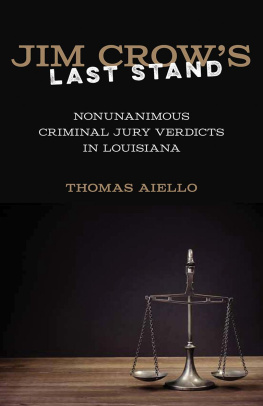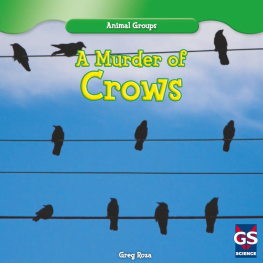JIM CROWS LAST STAND
JIM CROWS
LAST STAND
NONUNANIMOUS CRIMINAL JURY VERDICTS IN LOUISIANA
THOMAS AIELLO
UPDATED EDITION

LOUISIANA STATE UNIVERSITY PRESS
BATON ROUGE
Published by Louisiana State University Press
Copyright 2015 by Louisiana State University Press
New material copyright 2019 by Louisiana State University Press
All rights reserved
Manufactured in the United States of America
Louisiana Paperback Edition, 2019
DESIGNER: Mandy McDonald Scallan
TYPEFACE: Whitman
PRINTER AND BINDER: LSI
Library of Congress Cataloging-in-Publication Data
Names: Aiello, Thomas, 1977 author.
Title: Jim Crows last stand : nonunanimous criminal jury verdicts in Louisiana / Thomas Aiello.
Description: Updated edition. | Louisiana paperback edition. | Baton Rouge : Louisiana State University Press, 2019. | Includes bibliographical references and index.
Identifiers: LCCN 2019005202| ISBN 978-0-8071-7237-7 (pbk. : alk. paper) | ISBN 978-0-8071-7252-0 (pdf) | ISBN 978-0-8071-7253-7 (epub)
Subjects: LCSH: JuryLouisianaHistory20th century. | Discrimination in criminal justice administrationLouisianaHistory20th century.
Classification: LCC KFL581 .A945 2019 | DDC 345.763/056dc23
The paper in this book meets the guidelines for permanence and durability of the Committee on Production Guidelines for Book Longevity of the Council on Library Resources. 
Pearl Harbor put Jim Crow on the Run.
That Crow cant fight for Democracy
And be the same old Crow he used to be
Although right now, even yet today,
He tries to act the same old way.
But India and China and Harlem, too,
Have made up their minds Jim Crow is through.
LANGSTON HUGHES, Jim Crows Last Stand (1943)
CONTENTS
PREFACE TO THE UPDATED EDITION
The Sabine Parish courthouse has no metal detector. It is the first thing one notices when walking into the quaint but still imposing edifice in tiny Many, Louisiana, itself quaint and imposing in its own way. I traveled there in July 2018 to testify in an appeal of the second-degree murder conviction of Melvin Maxie, a conviction attendant with a variety of procedural inconsistencies, but also attendant with a nonunanimous jury conviction. That was why I was there. In the days and weeks prior, I had been brushing up on the subject in aid of serving as an expert witness in Maxies appeal, rereading old files and discovering some of the amazing new work on nonunanimous jury trials produced since the original publication of JimCrowsLastStand in 2015. I was in regular contact with Richard Bourke, director of the Louisiana Capital Assistance Center, a nonprofit that provides legal defense services to indigent defendants charged with capital crimes. This case, however, was different. Melvin Maxie was not on death row. But Bourke had taken over his appeal and in the process decided, like so many before him, to take on Maxies nonunanimous jury conviction as part of his argument for a new trial.
The plan was to deal specifically with the opinion in State v. Hankton (2013), in which judge Dennis J. Waldron argued that the revision of a less-than-unanimous jury requirement in the 1974 Constitution was not by routine incorporation of the previous Constitutions provisions. To the contrary, the new article was the subject of a fair amount of debate. In that debate no mention was made of race. The stated purpose behind the latest iteration of the less-than-unanimous jury verdict provision is judicial efficiency. On top of that, he argued, the 1974 constitution was submitted for a popular vote.
It was an interesting argument but not one particularly difficult to disprove. Waldron reasoned that Louisianas change from 93 majority verdicts to 102 majority verdicts in 1974 abrogated the original racist intent of the 1898 constitution that created the nonunanimous standard because the 1973 convention that created the new formula was not overtly proclaiming white supremacy. The problem with such a claim was that it ignored history and context. It ignored the racial realities of early 1970s Louisiana. It ignored that the starting point for all discussions of the nonunanimous jury provision in 1973 began with the original standard as it had been formed in 1898, and re-formed in 1913 and 1921. And it wrongly assumed that the promotion of a provision with original racist intent and clear racialized outcomes by someone along the way who did not happen to be particularly racist could make that provision somehow equitable.
In the course of reviewing materials to help make the case against such reasoning, I discovered a wealth of new information that had been published by legal scholars since the first appearance of Jim Crows LastStand. It was information that sometimes validated the claims of the book, and other times demonstrated that more needed to be said, that there were holes in my original account. The first edition of this book, for example, virtually ignores the role of Gilded Age black jury service as a motivating factor in the creation of the nonunanimous jury constitutional provision in 1898 and the implications of that role in the context of the nineteenth-century debate. It also ignores some of the racial context of the 1970s that would help respond to Waldrons Hankton opinion. It also could not help but leave out the legal developments since its original publication. In March 2018, state senator J. P. Morrell introduced a bill to amend the Louisiana constitution requiring unanimous juries for all criminal verdicts. It was successful in early June, and the amendment went on the ballot in November. Grassroots organizers canvassed the state. Former Grant Parish district attorney Ed Tarpley campaigned tirelessly for the amendment. The Unanimous Jury Coalition formed chapters in New Orleans, Lafayette, Baton Rouge, and Shreveport. The issue gained bipartisan support across the state and ultimately, seemingly miraculously, passed by a wide margin.
The night before my testimony at the Sabine Parish courthouse, I met with Bourke, legal scholar Thomas Ward Frampton, who was also testifying, and a group of dedicated clerks in a first-floor motel room in Natchitoches. There were files stacked around the room, a printer in front of the television. I sat on the bed closest to window. The air conditioning unit next to me blasted a cool breeze into a room that would have otherwise been heavy with the heat of the Louisiana summer and the apprehension of the next days events. We rehearsed the history of nonunanimous criminal jury verdicts, the line of questioning, the strategy of testimony. The others in the cramped motel room were used to such plottings, to the intensity of the night before a trial. But it was my first time. I told them all, giddy with anticipation, that I felt like I was in a scene from A Few Good Men, the one with Tom Cruise stalking around with a baseball bat as the defense team debated ideas and scribbled on a whiteboard in preparation for the impending trial.
Except that this was not fiction. Melvin Maxie was waiting in jail, a brief respite from the prison cell he normally called home, a grim reality only because his trial had happened in Louisiana. If it had taken place across the state line in Texas, a 102 verdict would have given him another opportunity. But this was Louisiana. I walked back out into the hot July night, back to my own motel room, to do more reading before the next days events.
My wife and I got to the courtroom early, anticipating a longer drive to Many, a small town thirty miles west of Natchitoches. Walking into a courthouse without a metal detector made her nervous, but I liked the more welcoming atmosphere. Where one might normally see signposts of diligence in other courthouses, here there were a few scattered magazines and a plastic bag filled with soda can pull tabs. We sat patiently in the hallway where the bailiff reassured us that the courtroom would open shortly. He smiled and confirmed we were in the right place. We entered when the courtroom finally opened. There was a sign on the door warning everyone who entered that no food, drink, chewing gum, or cell phones were allowed inside, but everyone was eating, drinking, chewing gum, and staring into cell phones. It was the relaxed atmosphere infused with the tension of a life hanging in the balance that one might expect in a courthouse without a metal detector. We sat and stared at the wood-paneled walls as Maxies family made its way into the room, sitting in the rows in front of us. Then Maxie himself came in, chained at the wrists and ankles, wearing an orange jumpsuit but smiling at those who came to see him that day.
Next page






